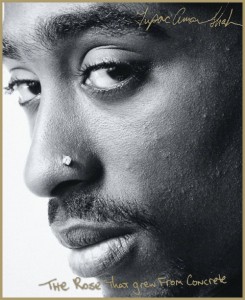 The Rose That Grew From Concrete
The Rose That Grew From Concrete
Genre: Dramatic Feature
Leading Characters: TUPAC AMARU SHAKUR
Logline: Malcolm X meets What’s Love Got To Do With It?
Rating: PG 13
Running Time: 120 Minutes
THE ROSE THAT GREW FROM is a real time dramatization of the last two hours TUPAC spent before he was shot. The Tyson fight at MGM, the fight in the lobby and finally the white Cadillac pulling up to the car TUPAC and Suge Knight are in and shooting TUPAC. The shooting action would be filmed in a John Woo styled slow motion as each bullet, like the stakes in Christ’s body, enters TUPAC’s body. Then we are in the hospital room where TUPAC is literally fighting for his life. This is also where TUPAC will metaphorically fight for his life by reliving it and the choices he made that led him to make the deal with the devil – Suge Knight – Digital underground and Death Row Records.
The primary narrative inter-cuts this narrative using the Television in TUPAC’s hospital room as a device for the audience and TUPAC to watch himself as the last days of his life are played out before the entire world. We crosscut to actual dramatic scenes with Suge Knight and the Bloods and the ten “hits” that were placed and carried out during that time. We deal with the police investigation in Las Vegas.In the hospital room TUPAC gets up from the coma – a mystical state anyway; TUPAC rises like Christ to talk to himself and work out a way to peace with his life and the eventuality that he will die before his time. We experience the dilemma and conflict that is inside TUPAC to be what his “friends” and fans want him to be – THUG PRINCE OF RAP or the real artistic genius who leaves Rap behind and ascends to singing, dancing, acting, writing, directing and producing his own projects as he had dreamed.
Artistic elements of the film production include special effects where TUPAC is furiously writing a poem or rap and we not only see him physically writing, but we see the words appear on the wall directly behind him; to further demonstrate his genius and how fluid and near perfect his process was even in first draft! Also how he recorded his life in poetry as it happened. Other effects are scenes where his hospital Television serves to show his life and recording sessions. The audience is introduced to younger versions of TUPAC when he was growing up, attending the Baltimore School for the performing arts: dancing ballet and singing and acting. We will also see his struggle with poverty and the realities of having a mother hooked on crack and having to move around from place to place, shelter to shelter. Finally, each day of the last days of his life will be illustrated by a time/clock like feature placed on the Television in the hospital room, showing both TUPAC and the audience how time is slipping away from TUPAC, as he struggles for life. For seven days TUPAC lies in a coma, with his life being played out on the news via the Television in the hospital room. At the moment of TUPAC’s final passing, we see the hospital equipment fail and his heartbeat slowly grind to a halt, like a final cadence of a musical phrase. Via the Television, a reporter’s voice will announce – “the passing of one Lesane Crooks, also known as TUPAC AMARU SHAKUR and possibly, finally MACHIAVILLI.”

